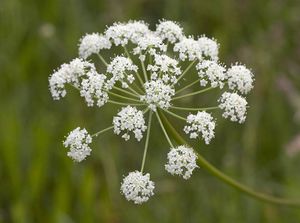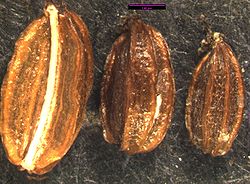Difference between revisions of "Ligusticum apiifolium"
| (14 intermediate revisions by 4 users not shown) | |||
| Line 1: | Line 1: | ||
| − | ''Ligusticum | + | * Scientific Name: ''Ligusticum'' ''apiifolium'' |
| − | + | * Family: Apiaceae | |
| + | * Common Names: celery-leaf wild lovage, parsely-leaf wild lovage | ||
| + | * Synonyms/Misapplications: ''Cynapium'' ''apiifolium'' | ||
| + | * Codon: LIGAPI | ||
| + | ---- | ||
| + | [[File:LIGAPI1.jpg |thumb|Photo by Rod Gilbert, 2006, also featured on Main Page]] | ||
===Taxonomy=== | ===Taxonomy=== | ||
| + | {{Taxobox | ||
| + | | image = | ||
| + | | image_caption = Photo by Rod Gilbert, 2006. Also featured on Main Page | ||
| + | | name = | ||
| + | | regnum = [[Plant]]ae | ||
| + | | subregnum = Viridiplantae | ||
| + | | phylum = Tracheophyta | ||
| + | | subphylum= Spermatophytina | ||
| + | | classis = Magnoliopsida | ||
| + | | subclassis = Asteranae | ||
| + | | ordo = Apiales | ||
| + | | familia = Apiaceae | ||
| + | | genus = ''Ligusticum'' L. | ||
| + | | species = ''''' Ligusticum apiifolium''''' (Nutt. ex Torr. & A. Gray) A. Gray | ||
| + | | subspecies = | ||
| + | }} | ||
| + | <ref>Integrated Taxonomic Information System. Retrieved from https://www.itis.gov/servlet/SingleRpt/SingleRpt?search_topic=TSN&search_value=29525</ref> | ||
| − | + | ===Description=== | |
| − | + | Taprooted perennial herb, 4-15 dm tall. | |
| − | + | ||
| − | + | ||
| − | + | ||
| − | + | ||
| − | + | ||
| − | + | ||
| − | + | ||
| − | + | ||
| − | + | Dissected leaves, leaflets also deeply pinnately lobed, petiole generally 1-3 dm. | |
| − | + | ||
| − | + | Inflorescence of compound umbels, involucre and involucel both absent or inconspicuous. Pedicels unequal, rays of umbel usually 12-30, flowers white, petals five. | |
| − | + | ||
| − | + | Ribs of fruit are wingless, carpophore bifid (divided into two) to base, stylopodium conic.<ref name=":0">Hitchcock, C. L., Cronquist, A., Giblin, D., & Legler, | |
| − | '' | + | B. et al. (2018). ''Flora of the Pacific Northwest: an illustrated manual''. |
| + | Seattle: University of Washington Press.</ref> | ||
===Bloom Period=== | ===Bloom Period=== | ||
| − | - | + | May-July.<ref>WTU Herbarium, Burke Museum, |
| + | & University of Washington. Retrieved from <nowiki>https://biology.burke.washington.edu/herbarium/imagecollection/taxon.php?Taxon=Ligusticum%20apiifolium</nowiki></ref> | ||
===Distribution=== | ===Distribution=== | ||
| + | Lowland west Cascades, southern Olympic Peninsula, and southern Puget Trough to California.<ref name=":0" /> | ||
===Habitat=== | ===Habitat=== | ||
| + | Lowland wooded slopes, prairies, and fencerows.<ref name=":0" /> | ||
===Uses=== | ===Uses=== | ||
| − | + | Karuk use as of infusion of roots to stimulate apetite.<ref>Schenck, Sara M. and E. W. Gifford, 1952, Karok Ethnobotany, Anthropological Records 13(6):377-392, page 387</ref> | |
| − | + | ||
| − | + | ||
| − | + | ||
| − | + | ||
| + | Pomo use of root decoction for pulmonary hemorrhage.<ref name=":1">Native American Ethnobotany Database. Retrieved from <nowiki>http://naeb.brit.org/uses/search/?string=Ligusticum+apiifolium</nowiki></ref> | ||
| + | Kashaya Pomo use of root decoction for anemia.<ref name=":1" /> | ||
| + | ==== Ecological ==== | ||
| + | Host plant for ''Agonopterix rosaciliella'' moth.<ref name=":2">''Lovage, Ligusticum apiifolium''. California Native Plant Society. <nowiki>https://calscape.org/Ligusticum-apiifolium-()</nowiki>.</ref> | ||
| + | ===Propagation=== | ||
| + | No treatment needed to propagate by seed.<ref name=":2" /> | ||
===Seed=== | ===Seed=== | ||
| − | |||
| − | |||
| − | |||
'''Seed sample from:''' 2011 | '''Seed sample from:''' 2011 | ||
| Line 45: | Line 62: | ||
'''Measurement Range:''' L: 4 – 5, W: 2 – 2.5, D: 1 – 2 | '''Measurement Range:''' L: 4 – 5, W: 2 – 2.5, D: 1 – 2 | ||
| + | |||
| + | [[File:LIAP LisaHintz sd 2012.jpg|250px|thumb| | ||
| + | ''Ligusticum apiifolium'' seeds, photo by Lisa Hintz | ||
| + | ]] | ||
====Features==== | ====Features==== | ||
| Line 56: | Line 77: | ||
'''Longitudinal Cross Section:''' elliptical [[File:LIAP long.png]] | '''Longitudinal Cross Section:''' elliptical [[File:LIAP long.png]] | ||
| + | |||
| + | ===Photo Gallery=== | ||
| + | |||
| + | ===References=== | ||
Latest revision as of 21:59, 20 March 2021
- Scientific Name: Ligusticum apiifolium
- Family: Apiaceae
- Common Names: celery-leaf wild lovage, parsely-leaf wild lovage
- Synonyms/Misapplications: Cynapium apiifolium
- Codon: LIGAPI
Contents
Taxonomy
| Scientific classification | |
|---|---|
| Kingdom: | Plantae |
| Subkingdom: | Viridiplantae |
| Phylum: | Tracheophyta |
| Subphylum: | Spermatophytina |
| Class: | Magnoliopsida |
| Subclass: | Asteranae |
| Order: | Apiales |
| Family: | Apiaceae |
| Genus: | Ligusticum L. |
| Species: | Ligusticum apiifolium (Nutt. ex Torr. & A. Gray) A. Gray |
Description
Taprooted perennial herb, 4-15 dm tall.
Dissected leaves, leaflets also deeply pinnately lobed, petiole generally 1-3 dm.
Inflorescence of compound umbels, involucre and involucel both absent or inconspicuous. Pedicels unequal, rays of umbel usually 12-30, flowers white, petals five.
Ribs of fruit are wingless, carpophore bifid (divided into two) to base, stylopodium conic.[2]
Bloom Period
May-July.[3]
Distribution
Lowland west Cascades, southern Olympic Peninsula, and southern Puget Trough to California.[2]
Habitat
Lowland wooded slopes, prairies, and fencerows.[2]
Uses
Karuk use as of infusion of roots to stimulate apetite.[4]
Pomo use of root decoction for pulmonary hemorrhage.[5]
Kashaya Pomo use of root decoction for anemia.[5]
Ecological
Host plant for Agonopterix rosaciliella moth.[6]
Propagation
No treatment needed to propagate by seed.[6]
Seed
Seed sample from: 2011
Average Measurement: 4.5 x 2.1 x 1.4
Measurement Range: L: 4 – 5, W: 2 – 2.5, D: 1 – 2
Features
Shapes: Seeds have two distinct seed faces. One side is more flattened or concave, and the other is more convex. Hilum tapered, opposite apex rounded. Color: Entire seed several shades of brown.
Surface: One seed face has several distinct ridges running longitudinally from hilum to opposite apex. The other seed face has one longitudinal white line running from hilum to opposite apex. Seeds sometimes wrinkled or slightly bumpy, and somewhat lustrous.
Latitudinal Cross Section: ovate 
Longitudinal Cross Section: elliptical ![]()
Photo Gallery
References
- ↑ Integrated Taxonomic Information System. Retrieved from https://www.itis.gov/servlet/SingleRpt/SingleRpt?search_topic=TSN&search_value=29525
- ↑ 2.0 2.1 2.2 Hitchcock, C. L., Cronquist, A., Giblin, D., & Legler, B. et al. (2018). Flora of the Pacific Northwest: an illustrated manual. Seattle: University of Washington Press.
- ↑ WTU Herbarium, Burke Museum, & University of Washington. Retrieved from https://biology.burke.washington.edu/herbarium/imagecollection/taxon.php?Taxon=Ligusticum%20apiifolium
- ↑ Schenck, Sara M. and E. W. Gifford, 1952, Karok Ethnobotany, Anthropological Records 13(6):377-392, page 387
- ↑ 5.0 5.1 Native American Ethnobotany Database. Retrieved from http://naeb.brit.org/uses/search/?string=Ligusticum+apiifolium
- ↑ 6.0 6.1 Lovage, Ligusticum apiifolium. California Native Plant Society. https://calscape.org/Ligusticum-apiifolium-().


